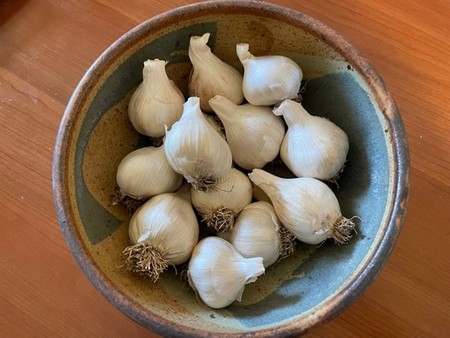Whether you fall into the camp of a little goes a long way or too much is never enough, I hope to convince you that growing garlic is worthy of your time and some space in the garden. Let's look at this amazing and ancient plant.

Historically garlic grew wild over much of Europe, Central Asia and the Far East. There are references to garlic going back as far as 5000 years ago. It is believed that softneck garlic was the first cultivated garlic. It has only been in the last 1000 years that the distinction was made between hardneck and softneck garlic.
Let's investigate the difference between hardneck and softneck garlic, as they vary in their structure, flavor, and growing requirements.
• Hardneck garlic is cold hardy and known for its robust, strong flavor. This garlic typically yields fewer cloves, with each clove being large and plump. Hardneck garlic has a central, hard stalk and produces garlic scapes, which are the flowering stem. These edible scapes are produced in late spring or early summer.
• Softneck garlic is better suited to growing in warmer climates. It has a milder, less pungent flavor profile. Softneck garlic bulbs have more cloves, but the cloves are smaller. Softneck garlic has no hard, central stalk and does not produce scapes, but if you want to braid your garlic, you need to grow softneck garlic. This is the grocery store type, available because it has a longer shelf life.
Planting garlic is easy but be aware when you put it in the ground you are dedicating that garden plot for 8–10 months. I like to use the rotation of putting garlic in the ground in mid-October which allows for harvest in June when the soil is warm enough to put peppers in the ground after the garlic is pulled out. Make sure you select a variety of garlic which is mature in under 240 days.
The reason for fall planting is that the lingering warmth of the soil allows the roots to get established and allows the bulbs to develop some leaf growth before colder weather begins. Garlic needs cold temperatures to stimulate root growth. Hardneck garlic requires 4–6 weeks of cold below 40–45° F. to develop a strong bulb. This chilling process is called vernalization. Softneck garlic is less demanding and does not need the extended chill hours. This makes softneck garlic a good choice where winter temperatures are mild.
Garlic will go dormant during the cooler months but will reawaken when the soil warms in the spring, giving it a jump start on the growing season. If you miss the October planting date, you can plant in February in our Contra Costa County growing zones, but your garlic bulbs will be small. Spring planting should be your last resort. In our clay soil, raised beds are a good choice, as garlic bulbs can rot in wet, clay soil.
It is recommended that you purchase “seed garlic” because it is grown for planting out and does not go into the grocery store pipeline. Seed garlic is bred to be pest and disease free. It will not have been treated with a sprouting inhibitor which may have been applied to grocery store garlic. I know gardeners who grow grocery store garlic successfully, but my personal choice is seed garlic, if for no other reason than the wonderful and diverse varieties available.
You will need to cover the garlic with a nice cushion of mulch during the colder months. Dry leaves or straw work well for this purpose. In the spring, when you see new growth on the garlic, pull back the mulch so the soil can begin to warm. When new growth appears, begin a schedule for fertilizing. Weeds are the enemy of garlic so weed early and often, but gently so you don't disturb the bulbs.
I hope you have the space and are willing to invest the time it takes to grow a bed of garlic. I think you will be richly rewarded.
For cultural information on watering, fertilizing, and harvesting, stay tuned for the next post.
Garlic: A Brief History (from the University of Missouri): https://ipm.missouri.edu/meg/2015/9/garlic-a-brief-history/
Help Desk of the UC Master Gardeners of Contra Costa County (BHD)